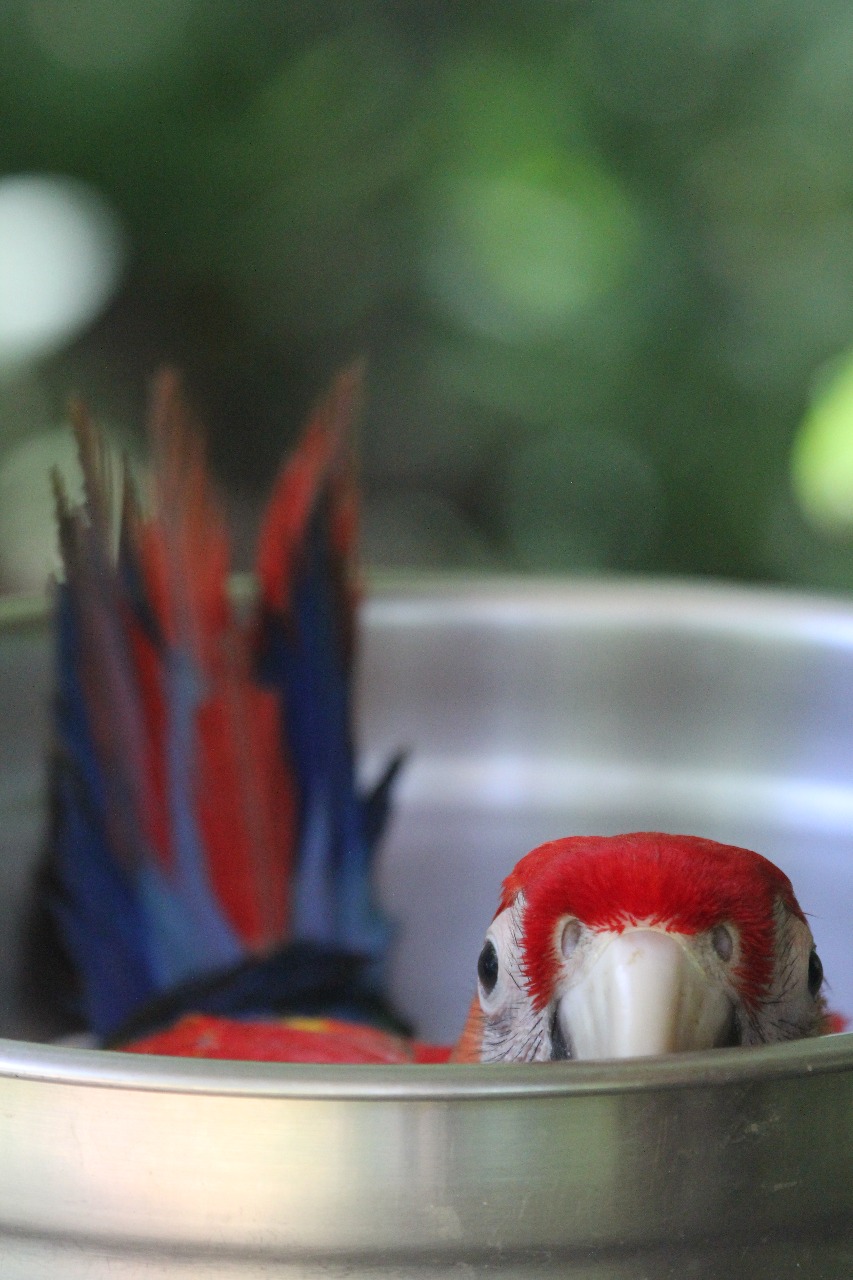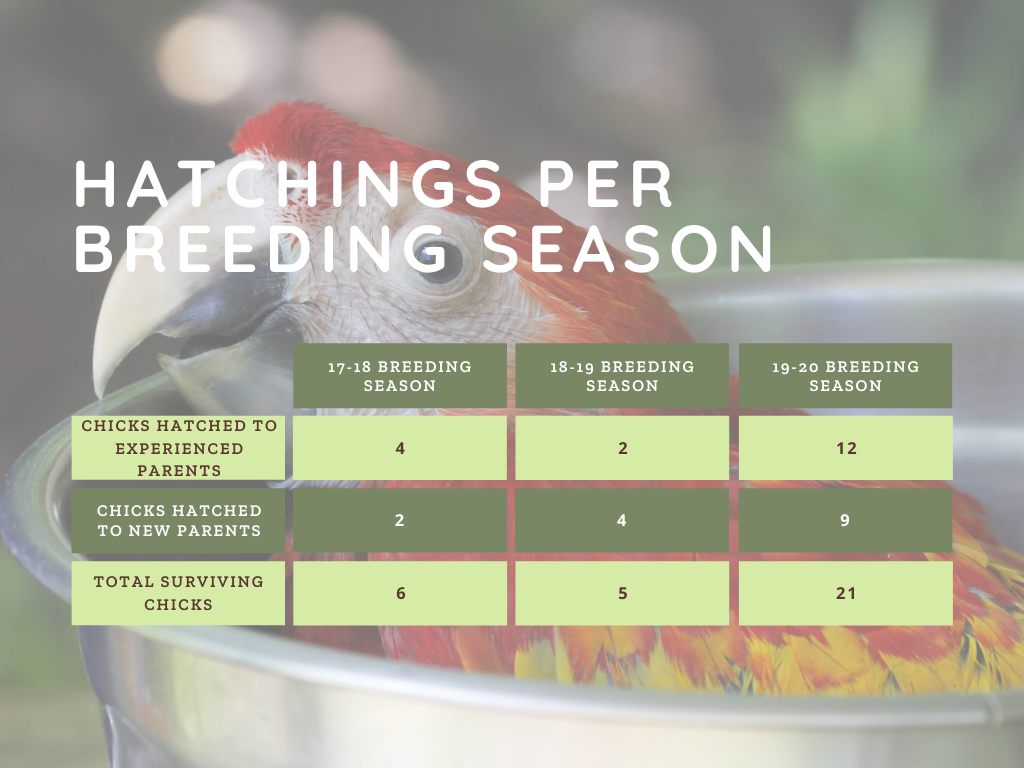
Due to the hard work of the staff, volunteers, and macaw parents, this year has seen an unprecedented number of chicks hatch and survive their first week of life at Macaw Recovery Network. Changes in multiple areas of our work have accumulated and worked together synergistically to produce a record-breaking season for our birds at MRN so far.
Currently, in the nests at Punta Islita Breeding Center, our macaw parents are carefully tending to 13 Great Green Macaw chicks and 4 Scarlet Macaw chicks. Additionally, there are two more eggs that have been laid but hold very little potential of being fertile and hatching.
Excitingly, 9 of the 21 chicks this season brought to the Captive Breeding Center hatched to new parents. Six of them have survived their first months and are growing healthily at our aviaries. Though having chicks born to experienced veteran parents is always great news, having chicks born to new parents means the potential from many more future chicks to be born to this new confirmed pair in the future. The more fertile breeding pairs we have, the more chicks our center can produce for release.
This year, a high percentage of nesting attempts produced chicks. This means that of eggs laid, more of them developed into chicks than they did in past years. The average number of eggs laid in each active nest is 1.31, up from just 0.21 last year.
As the season closes up and almost all chicks have fledged their nests, we look back and celebrate this year’s chick survival rates, as this brings us closer too making a real impact on Macaw populations in Costa Rica. Currently, our chick survivability past the first month of life is 80%, up from last year’s 45% survivability. This is significant because the first month of life is usually the most vulnerable period of a macaw’s life. In fact, only about 20% of wild chicks survive this critical period (Brightsmith).
Animal husbandry and breeding is a unique scientific field because it is fundamentally multi-faceted. In other disciplines of science, researchers can isolate a variable and change the variable to see if it changes a given result. In our case, since breeding success is so crucial, we cannot afford to split our birds into control and study groups and compare one individual factor on breeding success at a time. Instead, for the best results, we improve every variable we can in every nest at once. Because of this, it is impossible to point to a single cause of our success this year. In fact, our success is likely due to the combined changes to the birds’ breeding environment. Here are some notable changes (in no particular order) that I believe contributed most profoundly to the recent reproductive success of the birds.

The Rest Year
Last year, our programs manager experimented with giving consistent breeders a year to rest and recuperate from reproduction. Laying eggs and rearing chicks is very energetically costly, especially for female birds. Giving pairs the ability to rest was thought to improve their overall health and possibly increase their future fecundity. Four of our current chick-bearing nests belong to experienced parents that took a year off last year. However, this rest cannot account for the entire increase in reproductive success as the remaining four chick-bearing nests belong to brand new parents.
Diet Changes
This year, the diets of all birds on site have been modified to provide them with more fat. Articles in the Audubon Society’s journal, The Auk suggest that passerine birds with higher body fat are able to produce more offspring. Additionally, the fruiting season for many fatty food sources (including multiple varieties of palm fruits and nuts) occurs during the macaw’s breeding season. We believed that an increase in dietary fat could stimulate our birds to breed so we began feeding them peanuts three times a week. Though peanuts are a very expensive food item to buy, it seems the cost has produced an exceedingly precious reward. We have also increased the frequency of feeding the parents of young chicks to three times a day to guarantee that the parents always have an abundance of fresh food to feed their young.
Parasite Elimination
A big risk of housing captive birds in their native range is that wild birds can pass diseases to the captive birds through contact or dropped feces. Internal parasites have been a constant struggle to prevent, diagnose, and treat through the years. This year we finally cracked the code and, with the help of multiple veterinarians from international backgrounds, found a mix of drugs that have reduced our parasite count to zero across the site. As previously mentioned, proper nutrition is important to the macaws’ fertility. With parasites leeching nutrients from inside, proper nutrition is hard to control. It is possible that the elimination of internal parasites allowed the macaws to put on a bit more visceral fat and have the nutrients they need to produce lots of chicks.
Nest Box Design Changes
This year, the nest boxes provided to the birds were of larger dimensions than usual and crafted from a different variety of wood. They were based directly upon the measurements of last year’s most successful nests. This year, more nest boxes are being used than in previous years and it is possible that the new dimensions and materials increased the macaws’ interest in the nests.
Reduced Contact with Chicks
Another significant change between this year and previous years is that this year, keepers are making an effort to keep contact with chicks under a week old to a minimum. Previously, we removed chicks from the nest three times during the first week to weigh them and determine whether they were gaining weight according to a normal growth curve. This year, when possible, we have only conducted visual checkups of the chicks in the nest and, if it was crucial to touch a chick, they were handled with sterile gloves. We believe that this decrease in nest contamination may have contributed to this year’s high survival rate.
Overall, we are proud to announce a very productive breeding season. Thank you all for your continued support of Macaw Recovery Network. Without our patrons and supporters, improvements to our practices would not be possible. We thank you all and cannot stress enough that our successes are yours to celebrate as much as they are ours.
Virginia Darby Moore
Bird Manager
Macaw Recovery Network


